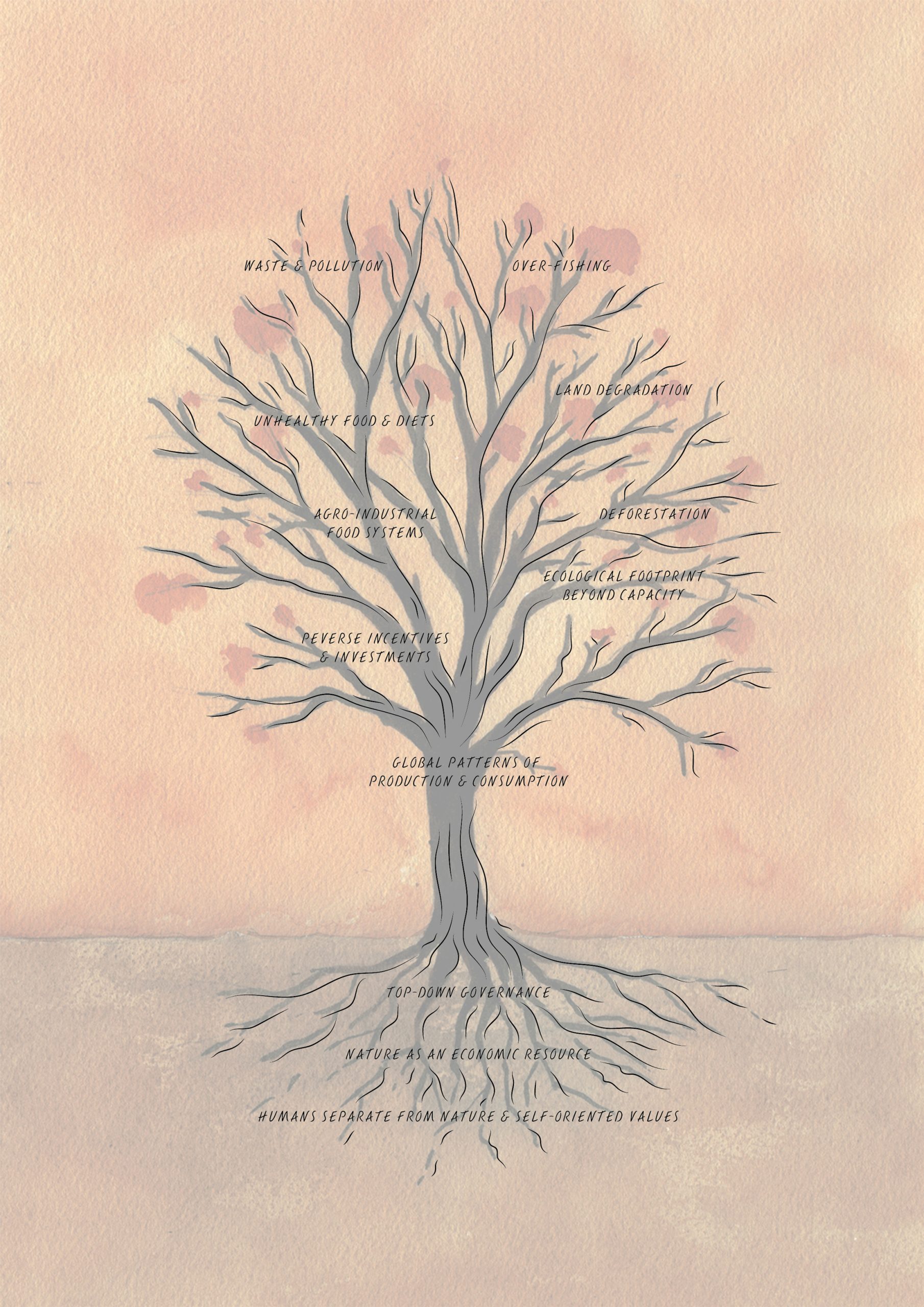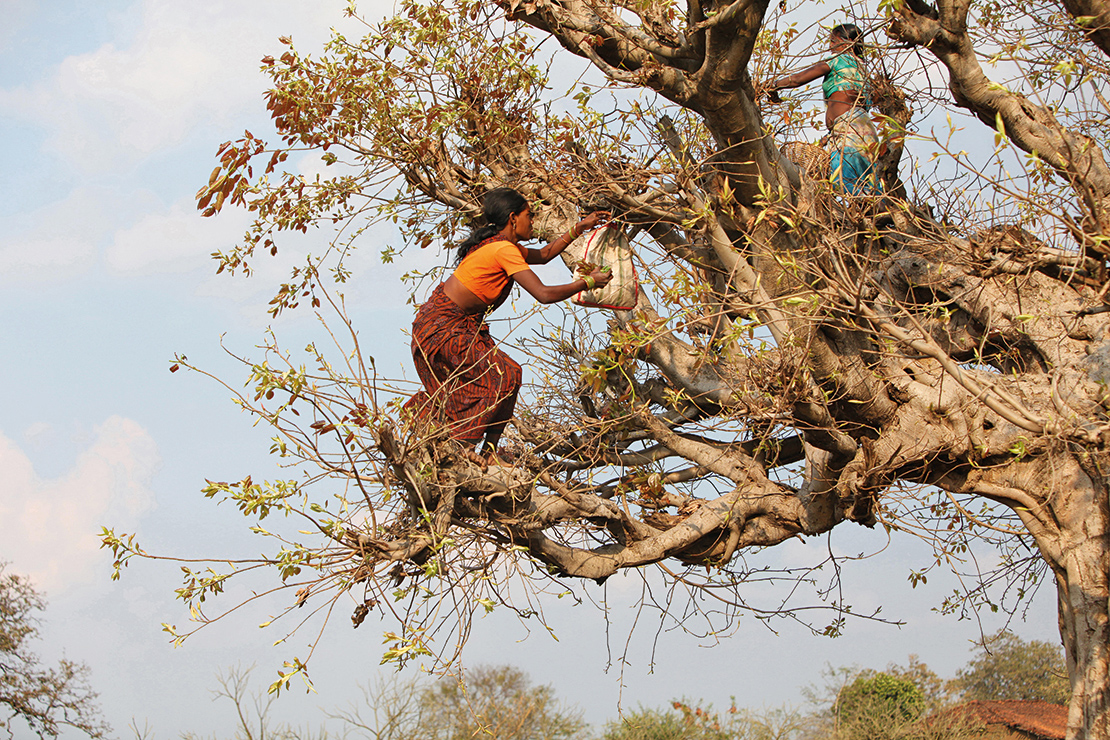Part IV
A Fulani family watering seedlings in Mali. Credit: Giacomo Pirozzi.
Transitions towards living in harmony with nature
IPLCs and biodiversity under threat
IPLCs today are acutely experiencing the loss of both biological and cultural diversity. These losses stem from unsustainable global systems of values, knowledge, governance, production, consumption, technology, economics, incentives and trade, all underlain by unequal decision-making power about the future of nature and peoples. The recent IPBES Global Assessment states that “IPLCs are directly and disproportionally impacted by biodiversity loss and climate change”.1
In the problem tree (see Figure 7), the roots of the problem arise from the separation of humans from nature, and from individual interests and profit-making. The same could be said for nature being separated from human interaction whereby the landscape, biodiversity and ecosystems depend and sometimes rely on human interaction to continue thriving as a holistic system. Nature is seen as an economic resource to be exploited and its degradation is treated as an externality of mainstream economics. Governance links the roots and the branches. Decision-making controlled by elites and powerful vested interests is often linked to systemic corruption and distortions of democratic rule, with large parts of society left behind. Incentives and subsidies are feeding the growth of unsustainable production and consumption patterns, and industrial agriculture that results in unhealthy foods and diets. The branches of the tree represent negative consequences which characterise the current biodiversity, climate and sustainable development crises, including deforestation, land degradation, over-fishing, water scarcity, waste and pollution.
Encroachment on and disruption of natural ecosystems and current industrial agricultural practices have also given rise to unprecedented opportunities for increased prevalence of multiple zoonotic diseases2, including coronaviruses, the latest causing COVID-19.3 The worldwide COVID-19 pandemic has exposed the vulnerabilities and lack of resilience of human health systems, simultaneously impacting economic and trade systems, financial systems, food systems, and social and political systems. These systemic and interrelated problems call for joined-up solutions that do not lock in ‘business as usual’ approaches, challenging humanity to urgently re-envisage and renew our social and cultural relationships with each other and with nature.

Problem tree of the current social-ecological crisis. Credit: artwork by Agnès Stienne.
Box 51: Adiwasi Samta Manch
Baiga women collect leaves in the forest. Credit: ephotocorp.

Case study: Baiga people living with Earth, central India
We, indigenous Baiga Adivasis in central India, have lived by the forest, allowing its biodiversity to regenerate. Access to our customary sustainable use of biodiverse forest as our life-source is, however, threatened by forestry, mining, ecotourism and other commercial purposes which capture our jungles.
— Read the full case study
Nature and culture transitions towards the 2050 vision
The values; ways of life; knowledge; resource governance and management systems; economies; and technologies of IPLCs have much to offer in addressing the biodiversity, climate and sustainable development crises, and in reimagining the diverse global systems that can deliver shared visions of solidarity and of “no one left behind”. IPLCs propose changes towards more balanced relationships within societies and with nature through six key transitions:
- Cultural transitions towards diverse ways of knowing and being
- Land transitions towards securing customary land tenure of IPLCs
- Governance transitions towards inclusive decision-making and self-determined development
- Incentives and financial transitions towards rewarding effective culture-based solutions
- Economic transitions towards sustainable use and diverse local economies
- Food transitions towards revitalising indigenous and local food systems.
Each of these transitions addresses specific urgent issues and contains its own dynamics, but all six transitions are systemically linked to each other; indeed, no single transition can succeed alone, and they need to take place simultaneously, and be deployed in mutually reinforcing ways, to maximise the potential for transformation. These transitions have now become imperatives for the survival of IPLCs and the continued health of the biosphere, the limits of which have been breached.
“In order to bend the curve of biodiversity loss, we need to bend the curve of inequality and ensure the equitable sharing of benefits and costs. To achieve the vision 2050, there is a need for a paradigm shift in terms of values at the center/core of society that influence their behaviour for a transformation towards a responsible and sustainable society.”
International Indigenous Forum on Biodiversity4
References
- IPBES (2019) Summary for policymakers of the global assessment on biodiversity and ecosystem services of the Intergovernmental Science-Policy Platform on Biodiversity and Ecosystem Services. S. Díaz, J. Settele, E. S. Brondízio E.S., H. T. Ngo, M. Guèze, J. Agard, A. Arneth, P. Balvanera, K. A. Brauman, S. H. M. Butchart, K. M. A. Chan, L. A. Garibaldi, K. Ichii, J. Liu, S. M. Subramanian, G. F. Midgley, P. Miloslavich, Z. Molnár, D. Obura, A. Pfaff, S. Polasky, A. Purvis, J. Razzaque, B. Reyers, R. Roy Chowdhury, Y. J. Shin, I. J. Visseren-Hamakers, K. J. Willis, and C. N. Zayas (eds.). Bonn, Germany: IPBES. Available at: https://doi.org/10.5281/zenodo.3553579
- Wallace, R. (2016) Big farms make big flu: Dispatches on influenza, agribusiness, and the nature of science. New York: Monthly Review Press.
- See for example: Carrington, D. (2020) ‘Halt destruction of nature or suffer even worse pandemics, say world’s top scientists.’ The Guardian. London: Guardian Media Group. Available at: https://www.theguardian.com/world/2020/apr/27/halt-destruction-nature-worse-pandemics-top-scientists
- International Indigenous Forum on Biodiversity (2019) ‘Submission of views on possible targets, indicators and baselines for the post-2020 global biodiversity framework and peer review of a document on indicators’, SCBD/OES/DC/KM/88539 (20 December 2019). Available at: https://chm.cbd.int/database/record?documentID=248755
—
International Indigenous Forum on Biodiversity (2020) ‘IIFB opening statement at the second meeting of the Open-ended Working Group on the post-2020 global biodiversity framework’, February 2020, IIFB. Available at: https://iifb-indigenous.org/open-ended-working-group-on-the-post-2020-global-biodiversity-framework/


